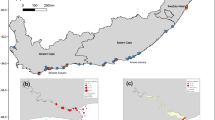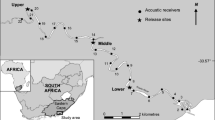Abstract
Passive acoustic telemetry was used to monitor the movements of cownose rays (Rhinoptera bonasus) within the Caloosahatchee River estuary in Southwest Florida. Twelve rays were tracked within the river between January 2004 and May 2005 for periods up to 234 days. Linear home range was calculated for all individuals and ranged between 0 and 18.4 km (daily) and 1 and 22.3 km (overall). Ray position within the river was compared to changing water quality parameters throughout the study. Although home range size did not increase with increasing salinity, individuals did occur farther upriver with decreasing flow rates and increasing salinity. There were no differences detected between day and night distribution patterns. Movement and presence patterns demonstrated significant use of the estuarine river over all months, indicating that cownose rays in southwest Florida may not undertake long seasonal migrations as established for other parts of their range.







Similar content being viewed by others
References
Able, K.W. 2005. A re-examination of fish estuarine dependence: Evidence for connectivity between estuarine and ocean habitats. Estuarine, Coastal and Shelf Science 64: 5–17. doi:10.1016/j.ecss.2005.02.002.
Bigelow, H.B., and W.C. Schroeder. 1953. Fishes of the Western North Atlantic. Part two: sawfishes, guitarfishes, skates, rays and chimaeroids. New Haven: Sears Foundation for Marine Research, Yale University.
Blaylock, R.A. 1989. A massive school of cownose rays, Rhinoptera bonasus (Rhinopteridae), in lower Chesapeake Bay, Virginia. Copeia 1989: 744–748. doi:10.2307/1445506.
Blaylock, R.A. 1992. Distribution, abundance and behavior of the cownose ray, Rhinoptera bonasus (Mitchill 1815), in lower Chesapeake Bay. Ph.D. Thesis, College of William and Mary, VA, USA.
Blaylock, R.A. 1993. Distribution and abundance of the cownose ray, Rhinoptera bonasus, in lower Chesapeake Bay. Estuaries 16: 255–263. doi:10.2307/1352498.
Bray, R.N., and M.A. Hixon. 1978. Night-shocker: Predatory behavior of the Pacific electric ray (Torpedo californica). Science 200: 333–334. doi:10.1126/science.200.4339.333.
Brewer, S.K., D.M. Papoulias, and C.F. Rabeni. 2006. Spawning habitat associations and selection by fishes in a flow-regulated prairie river. Transactions of the American Fisheries Society 135: 763–778. doi:10.1577/T05-021.1.
Cartamil, D.P., J.J. Vaudo, C.G. Lowe, B.M. Wetherbee, and K.M. Holland. 2003. Diel movement patterns of the Hawaiian stingray, Dasyatis lata: Implications for ecological interactions between sympatric elasmobranch species. Marine Biology 142: 841–847.
Childs, A.-R., P.D. Cowley, T.F. Næsje, A.J. Booth, W.M. Potts, E.B. Thorstad, and F. Økland. 2008. Do environmental factors influence the movement of estuarine fish? A case study using acoustic telemetry. Estuarine, Coastal and Shelf Science 78: 227–236. doi:10.1016/j.ecss.2007.12.003.
Clark, E. 1963. Massive aggregations of large rays and sharks in and near Sarasota, Florida. Zoologica 48: 61–64.
Collins, M.R., W.C. Post, D.C. Russ, and T.I.J. Smith. 2002. Habitat use and movements of juvenile shortnose sturgeon in the Savannah River, Georgia-South Carolina. Transactions of the American Fisheries Society 131: 975–979. doi:10.1577/1548-8659(2002)131<0975:HUAMOJ>2.0.CO;2.
Collins, A.B., M.R. Heupel, R.E. Hueter, and P.J. Motta. 2007a. Hard prey specialists or opportunistic generalists? An examination of the diet of the cownose ray, Rhinoptera bonasus. Marine and Freshwater Research 58: 135–144. doi:10.1071/MF05227.
Collins, A.B., M.R. Heupel, and P.J. Motta. 2007b. Residence and movement patterns of cownose rays Rhinoptera bonasus within a southwest Florida estuary. Journal of Fish Biology 71: 1159–1178. doi:10.1111/j.1095-8649.2007.01590.x.
Compagno, L.J.V. 1990. Alternative life history styles of cartilaginous fishes in time and space. Environmental Biology of Fishes 28: 33–75. doi:10.1007/BF00751027.
Cooke, S.J., C.M. Bunt, and J.F. Schreer. 2004. Understanding fish behavior, distribution and survival in thermal effluents using fixed telemetry arrays: A case study of smallmouth bass in a discharge canal during winter. Environmental Management 33: 140–150. doi:10.1007/s00267-003-0175-2.
Estevez, E.D. 1981. Charlotte harbor estuarine ecosystem complex: A summary of scientific information. Mote Marine Laboratory Review Series 3. Sarasota: Mote Marine Laboratory.
Estevez, E.D. 1986. Infaunal macroinvertebrates of the Charlotte Harbor Estuarine System and surrounding inshore waters, Florida. Water Resources Investigations Report No. 85-4260. Tallahassee: United States Geological Survey.
Fisher, R.A., and P.F. Lacey. 1991. Product development: Cownose ray (Rhinoptera bonasus). In Tropical and Subtropical Fisheries Technological Conference of the Americas Conference Proceedings, Sixteenth Annual Conference, 175–196. Gainesville, FL: Florida Sea Grant Program.
Geist, D.R., R.S. Brown, V. Cullinan, S.R. Brink, K. Lepla, P. Bates, and J.A. Chandler. 2005. Movement, swimming speed, and oxygen consumption of juvenile white sturgeon in response to changing flow, water temperature, and light level in the Snake River, Idaho. Transactions of the American Fisheries Society 134: 803–816. doi:10.1577/T04-108.1.
Grusha, D. 2005. Analysis of fall migration of cownose rays, Rhinoptera bonasus, using pop-up satellite archival tags. In Joint Meeting of Ichthyologists and Herpetologists Annual Meeting. Tampa, FL.
Heppel, S.S., L.B. Crowder, and T.R. Menzel. 1999. Life table analysis of long-lived marine species with implications for conservation and management. In Life in the slow lane: Ecology and conservation of long-lived marine animals, ed. J.A. Musick, 137–146. Bethesda: American Fisheries Society Symposium 23.
Heupel, M.R., and R.E. Hueter. 2001. Use of a remote acoustic telemetry system to monitor shark movements in a coastal nursery area. In Electronic tagging and tracking in marine fisheries, eds. J.R. Sibert, and J.L. Nielsen, 217–236. The Netherlands: Kluwer Academic.
Heupel, M.R., and C.A. Simpfendorfer. 2008. Movements and distribution of young bull sharks (Carcharhinus leucas) in a variable estuarine environment. Aquatic Biology 1: 277–289. doi:10.3354/ab00030.
Heupel, M.R., C.A. Simpfendorfer, and R.E. Hueter. 2004. Estimation of shark home ranges using passive monitoring techniques. Environmental Biology of Fishes 71: 135–142. doi:10.1023/B:EBFI.0000045710.18997.f7.
Hopkins, T.E. 1993. The physiological ecology of bat rays, Myliobatis californica, in Tomales Bay, California. Ph.D. dissertation, Univ. of California, Davis.
Hopkins, T.E., and J.J. Cech Jr. 1994. Effect of temperature on oxygen consumption of the bat ray, Myliobatis californica (Chondrichthyes, Myliobatidae). Copeia 1994: 529–532. doi:10.2307/1447005.
Hopkins, T.E., and J.J. Cech Jr. 2003. The influence of environmental variables on the distribution and abundance of three elasmobranchs in Tomales Bay, California. Environmental Biology of Fishes 66: 279–291. doi:10.1023/A:1023907121605.
Kieffer, M.C., and B. Kynard. 1996. Spawning of the shortnose sturgeon in the Merrimack River, Massachusetts. Transactions of the American Fisheries Society 125: 179–186. doi:10.1577/1548-8659(1996)125<0179:SOTSSI>2.3.CO;2.
Kraus, R.T., and D.H. Secor. 2005. Connectivity in estuarine white perch populations of Chesapeake Bay: Evidence from historical fisheries data. Estuarine, Coastal and Shelf Science 64: 108–118. doi:10.1016/j.ecss.2005.02.010.
Matern, S.A., J.J. Cech Jr., and T.E. Hopkins. 2000. Diel movements of bat rays, Myliobatis californica, in Tomales Bay, California: evidence for behavioral thermoregulation? Environmental Biology of Fishes 58: 173–182. doi:10.1023/A:1007625212099.
Myers, R.A., J.K. Baum, T.D. Shepherd, S.P. Powers, and C.H. Peterson. 2007. Cascading effects of the loss of apex predatory sharks from a coastal ocean. Science 315: 1846–1850. doi:10.1126/science.1138657.
Neer, J.A. 2005. Aspects of the life history, ecophysiology, bioenergetics, and population dynamics of the cownose ray, Rhinoptera bonasus, in the northern Gulf of Mexico. Ph.D. dissertation, Louisiana State University and Agricultural and Mechanical College, Baton Rouge, LA.
Neer, J.A., and B.A. Thompson. 2005. Life history of the cownose ray, Rhinoptera bonasus, in the northern Gulf of Mexico, with comments on geographic variability in life history traits. Environmental Biology of Fishes 73: 321–331. doi:10.1007/s10641-005-2136-5.
Neer, J.A., K.A. Rose, and E. Cortés. 2007. Simulating the effects of temperature on individual and population growth of Rhinoptera bonasus: a coupled bioenergetics and matrix modeling approach. Marine Ecology Progress Series 329: 211–233. doi:10.3354/meps329211.
Orth, R.J. 1975. Destruction of eelgrass, Zostera marina, by the cownose ray, Rhinoptera bonasus, in the Chesapeake Bay. Chesapeake Science 16: 205–208. doi:10.2307/1350896.
Peterson, C.H., F.J. Fodrie, H.C. Summerson, and S.P. Powers. 2001. Site-specific and density-dependent extinction of prey by schooling rays: generation of a population sink in top-quality habitat for bay scallops. Oecologia 129: 349–356.
Rogers, C., C. Roden, R. Lohoefener, K. Mullin, and W. Hoggard. 1990. Behavior, distribution, and relative abundance of cownose ray schools Rhinoptera bonasus in the northern Gulf of Mexico. Northeast Gulf Science 11: 69–76.
Scholnick, D.A., and C.P. Magnum. 1991. Sensitivity of hemoglobins to intracellular effectors: Primitive and derived features. The Journal of Experimental Zoology 259: 32–42. doi:10.1002/jez.1402590106.
Schwartz, F.J. 1964. Effects of winter water conditions on fifteen species of captive marine fishes. American Midland Naturalist 71: 434–444. doi:10.2307/2423302.
Schwartz, F.J. 1965. Inter-American migrations and systematics of the western Atlantic cownose ray, Rhinoptera bonasus. In Association of Island Marine Laboratories of the Caribbean, Sixth Meeting. p.1., Isla Margarita, Venezuela.
Schwartz, F.J. 1990. Mass migratory congregations and movements of several species of cownose rays, genus Rhinoptera: A world-wide review. The Journal of the Elisha Mitchell Scientific Society 106: 10–13.
Silberhorn, G.M., S. Dewing, and P.A. Mason. 1996. Production of reproductive shoots, vegetative shoots, and seeds in populations of Ruppia maritima L. from the Chesapeake Bay, Virginia. Wetlands 16: 232–239.
Simpfendorfer, C.A., M.R. Heupel, and A.B. Collins. 2008. Variation in the performance of acoustic receivers and its implication for positioning algorithms in a riverine setting. Canadian Journal of Fisheries and Aquatic Sciences 65: 482–492. doi:10.1139/F07-180.
Smith, H.M. 1907. The fishes of North Carolina. North Carolina Geological and Economic Survey 2. 453 p.
Smith, J.W. 1980. The life history of the cownose ray, Rhinoptera bonasus (Mitchill 1815), in lower Chesapeake Bay, with notes on the management of the species. M.A. Thesis, College of William and Mary, Williamsburg, Virginia. 151 p.
Smith, J.W., and J.V. Merriner. 1985. Food habits and feeding behavior of the cownose ray, Rhinoptera bonasus, in lower Chesapeake Bay. Estuaries 8: 305–310. doi:10.2307/1351491.
Smith, J.W., and J.V. Merriner. 1987. Age and growth, movements and distribution of the cownose ray, Rhinoptera bonasus, in Chesapeake Bay. Estuaries 10: 153–164. doi:10.2307/1352180.
Snelson, F.F. Jr., and S.E. Williams. 1981. Notes on the occurrence, distribution, and biology of elasmobranch fishes in the Indian River lagoon system, Florida. Estuaries 4: 110–120. doi:10.2307/1351673.
Standora, E.A., and D.R. Nelson. 1977. A telemetric study of the behavior of free-swimming angel sharks Squatina californica. Bulletin of Southern California Academy of Sciences 76: 193–201.
Thompson, B.A., and J.S. Verret. 1980. Nekton of Lake Pontchartrain, Louisiana, and its surrounding wetlands. In Environmental analysis of Lake Pontchartrain, Louisiana, its surrounding wetlands and selected land uses. Volume 2, 711–864. New Orleans, USA: U.S. Army Engineer District.
Vaudo, J.J., and C.G. Lowe. 2006. Movement patterns of the round stingray Urobatis halleri (Cooper) near a thermal outfall. Journal of Fish Biology 68: 1756–1766. doi:10.1111/j.0022-1112.2006.01054.x.
Acknowledgements
B. Yeiser provided invaluable assistance with animal collection, data collection, equipment maintenance, and support. P. Motta provided advice and guidance. We would also like to thank T. Tucker, A. Summers, T. Wiley, M. Blagg, and R. Hueter for their field and/or laboratory support. Numerous volunteer student interns provided assistance during this project. This research was funded in part by the Mote Scientific Foundation, the National Shark Research Consortium (NOAA Fisheries), and the University of South Florida. P. Doering and K. Haunert from the South Florida Water Management District provided information on the Caloosahatchee River system and access to water quality data. A. Collins was the recipient of the Mote Marine Laboratory and University of South Florida Graduate Fellowship in Elasmobranch Biology during the course of this work. Two anonymous reviewers provided comments that improved this manuscript.
Author information
Authors and Affiliations
Corresponding author
Rights and permissions
About this article
Cite this article
Collins, A.B., Heupel, M.R. & Simpfendorfer, C.A. Spatial Distribution and Long-term Movement Patterns of Cownose Rays Rhinoptera bonasus Within an Estuarine River. Estuaries and Coasts 31, 1174–1183 (2008). https://doi.org/10.1007/s12237-008-9100-5
Received:
Revised:
Accepted:
Published:
Issue Date:
DOI: https://doi.org/10.1007/s12237-008-9100-5




